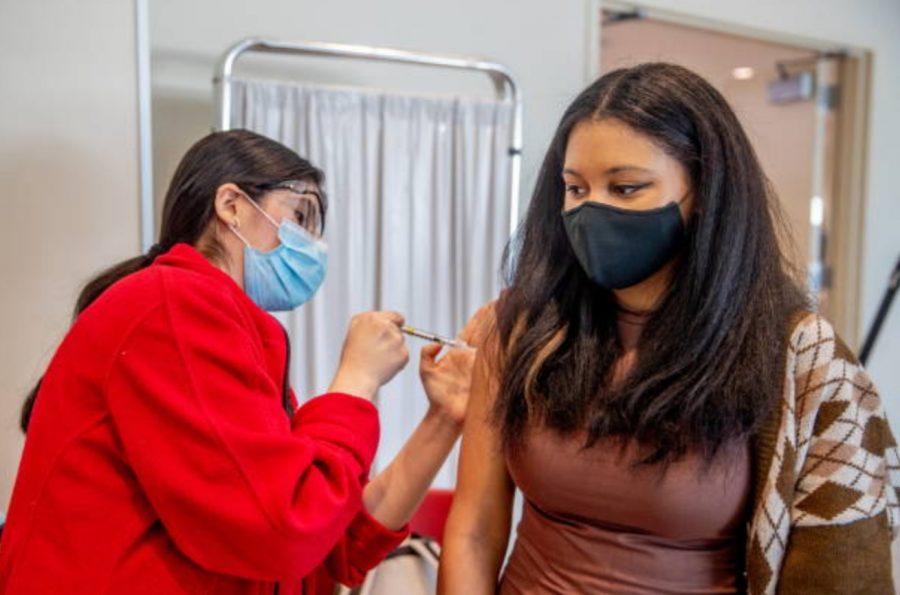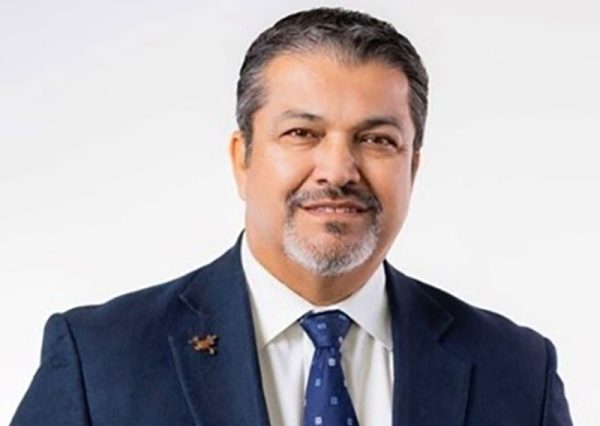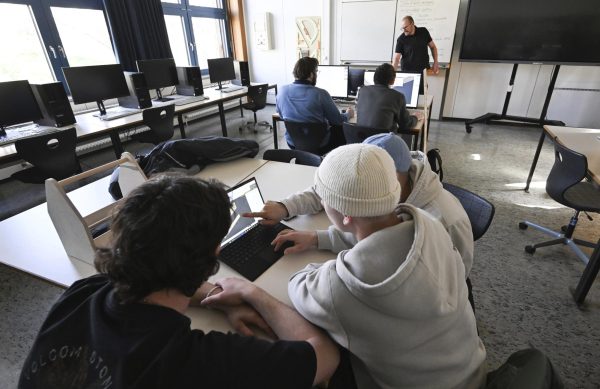Social media vaccine misinformation causes low vaccine rates in young adults
Photo courtesy of Getty Images/Raychel Brightman. Student recieves her first Moderna COVID-19 vaccine at Stony Brook University on April 6, 2021.
College students use social media to curb vaccine hesitancy and raise awareness despite harmful and misleading information regarding COVID-19 vaccines.
According to the World Health Organization (WHO), COVID-19 vaccine hesitancy has become a severe threat to global health despite 26% of the United States population being fully vaccinated. Though more than half of the US population has been fully vaccinated, many young adults remain undecided and hesitant about being vaccinated.
Monse Rivera, an English major at College of the Desert, with the help of a classmate reaching out to her via Instagram, could get access to a first-come, first-serve vaccine appointment at Eisenhower Medical Center Rancho Mirage.
At this time, Eisenhower currently has a pause on the administration of the Johnson & Johnson vaccine in guidance of the Riverside County Department of Public Health, Food and Drug Administration (FDA), and Centers for Disease Control and Prevention (CDC), due to six women ages 18 and 48 reported within the US to have contracted a rare and severe blood-clotting illness after receiving the single-dose vaccine. For the time being, the medical center will be offering the Pfizer and Moderna vaccines.
During a joint media briefing between the FDA and the CDC on April 13, Anna Schuchat, the principal deputy director at the CDC, stated that the CDC’s Advisory Committee on Immunization Practices (ACIP) is committed to a review of the available information and aggressive outreach to clinicians. Hence, they know how to diagnose, treat and report cases.
“The ACIPS will review the cases and the context of risks, benefits, and possible subsets of the population that may be in a different category,” said Schuchat. “We intend to provide an update regularly, and that the pause provides us time for deliberation and assuring appropriate diagnosis and treatment.”
Before the Johnson & Johnson vaccine recall, Rivera was still surprised to see that only a small number of individuals in her age bracket had shown up to receive their vaccine.
“Many of my classmates have said that they’re scared and unsure about getting vaccinated,” said Rivera. “It’s up to them if they choose to get vaccinated or not, but I don’t think it’s fair to everyone else who is trying to fight the virus.”
Rivera added, “Health officials stress the importance of getting vaccinated as being the start to the end of this pandemic, so I think it’s a matter of where some people are getting their information.”
Since the start of the pandemic, more and more young adults have referred to more social media platforms than traditional media as a source of information on COVID-19. The ages between 18 to 29 are the largest group to use at least one social media platform, averaging at 84%. In contrast, those ages 65 and older lie at 45% of the population that use at least one social media platform to the Pew Research Center.
Though it’s evident that social media has allowed for easy access to mass public information on COVID-19, the risk of widespread misinformation regarding the virus is prevalent. Once an individual presents their opinion as a fact, it becomes harder for others looking at the same information to be informed as it becomes difficult to distinguish real information as a fact without becoming misinformed.
Recent cases include a plethora of Twitter and Facebook accounts posting claims targeting both Pfizer and Moderna vaccines as toxic, causing fertility risks, and radiation exposure which has all been proven wrong. Accounts spreading such rumors and misinformation have either been removed or flagged as harmful and misleading.
Since the rise of COVID misinformation on social media, young adults have become more likely to be doubtful and hesitant of the vaccines, which only proves to drive the number of vaccinated young adults down, according to csis.org.
Karsyn Hughes, a criminal justice major at College of the Desert, is very active on social media platforms such as Twitter and Instagram. She noticed these rumors seem more consistent with conspiracies than accounts purposefully spreading misinformation to confuse users.
“I’ve read some posts saying that the vaccine will only make your body weaker and vulnerable to fighting other diseases, and have seen Twitter posts list false side effects,” says Hughes. “I think the goal of the accounts is to make people, especially those as young as me, fearful of the vaccine, but their claims are only spreading false information.”
Hughes added, “There’s already a stigma that younger adults are more likely to object to vaccines because of exposure to false information. Social media platforms are only keeping the stigma alive.”
Hughes believes that these social media platforms are receiving too much attention. She believes the key to countering online misinformation is by removing accounts keen on spreading misinformation and implementing reinforcements to prevent arguments on the platforms that only serve to give the accounts more coverage.
Both Rivera and Hughes have stated that since the start of the pandemic, people, now more than ever, rely on popular social media platforms to stay up to date on COVID-19 and vaccine information. Although, accounts spreading false information should be held responsible for their misleading content. Moreover, people shouldn’t feel the need to limit their use on certain social media platforms due to the spread of unregulated misinformation.

Adjoa is majoring in journalism and communications, and though her passion lies in writing, it also lies in humanitarian efforts. She aspires to become...







